Related Research Articles

Cumberland is a city in and the county seat of Allegany County, Maryland, United States. At the 2020 census, the city had a population of 19,076. Located on the Potomac River, Cumberland is a regional business and commercial center for Western Maryland and the Potomac Highlands of West Virginia. It is the primary city of the Cumberland metropolitan area, which had 95,044 residents in 2020.

Frostburg is a city in Allegany County, Maryland. It is located at the head of the Georges Creek Valley, 8 miles (13 km) west of Cumberland. The town is one of the first cities on the "National Road", US 40, and the western terminus of the Western Maryland Scenic Railroad. It is part of the Cumberland MD-WV metropolitan statistical area,

The Ludlow Massacre was a mass killing perpetrated by anti-striker militia during the Colorado Coalfield War. Soldiers from the Colorado National Guard and private guards employed by Colorado Fuel and Iron Company (CF&I) attacked a tent colony of roughly 1,200 striking coal miners and their families in Ludlow, Colorado, on April 20, 1914. Approximately 21 people, including miners' wives and children, were killed. John D. Rockefeller Jr., a part-owner of CF&I who had recently appeared before a United States congressional hearing on the strikes, was widely blamed for having orchestrated the massacre.
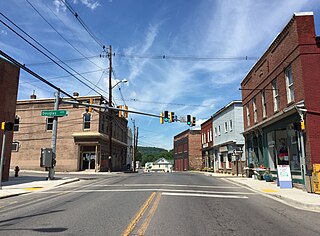
Georges Creek Valley is located in Allegany County, Maryland along the Georges Creek. The valley is rich in wide veins of coal, known historically as "The Big Vein." Coal was once extracted by deep mines but is only mined today through surface mining. The Georges Creek Valley was once a major center for the US coal industry.
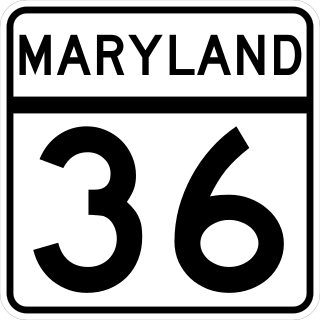
Maryland Route 36 is a 29.43-mile (47.36 km) state highway located in Allegany County, Maryland, United States. MD 36's southern terminus is at the West Virginia Route 46 (WV 46) bridge in Westernport and its northern terminus at U.S. Route 40 Alternate near Cumberland. Between Westernport and Frostburg, it is known as Georges Creek Road, and from Frostburg to Cumberland it is known as Mount Savage Road. Like the majority of Maryland state highways, MD 36 is maintained by the Maryland State Highway Administration (MDSHA).
The Aegis is a local newspaper in Harford County, Maryland, United States. Its first issue was published on February 2, 1923.
Eckhart Mines is an unincorporated community and census-designated place (CDP) in Allegany County, Maryland, United States. As of the 2010 census it had a population of 932.
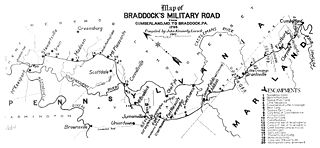
Cumberland, Maryland is named after the son of King George II, Prince William, the Duke of Cumberland. It is built on the site of the old Fort Cumberland, a launch pad for British General Edward Braddock's ill-fated attack on the stronghold of Fort Duquesne during the French and Indian War.
Cumberland, Maryland, has several media outlets, most carrying some form of satellite programming. WCBC-AM and the Cumberland Times-News actively collect their local news content, while WFRB-FM has some local news content, but do not actively collect it.
The Hoffman tunnel, or Hoffman drainage tunnel, was constructed to drain water from coal mines northwest of Clarysville in Allegany County, Maryland. The two-mile-long tunnel drains into the Braddock Run tributary of Wills Creek.

The Colorado Coalfield War was a major labor uprising in the Southern and Central Colorado Front Range between September 1913 and December 1914. Striking began in late summer 1913, organized by the United Mine Workers of America (UMWA) against the Rockefeller-owned Colorado Fuel and Iron (CF&I) after years of deadly working conditions and low pay. The strike was marred by targeted and indiscriminate attacks from both strikers and individuals hired by CF&I to defend its property. Fighting was focused in the southern coal-mining counties of Las Animas and Huerfano, where the Colorado and Southern railroad passed through Trinidad and Walsenburg. It followed the 1912 Northern Colorado Coalfield Strikes.

The Civilian & Telegraph was a Unionist newspaper published weekly in Cumberland, Maryland, from 1859 to 1905. It was created on March 17, 1859, from the merger of two newspapers, the Civilian and Telegraph. William Evans and John J. Maupin were the first editors.

The Democratic Advocate was a semiweekly newspaper published from November 30, 1865 to 1968 in Westminster, Carroll County, Maryland. Shortly after its predecessor, the Western Maryland Democrat, ceased publication due to violence from an angry mob in the aftermath of the assassination of Abraham Lincoln, former publisher William H. Davis established the Advocate in 1865. About a year later, Davis turned over operations to Joseph M. Parke, a lawyer and Democratic office holder.
The Citizen was a weekly newspaper published in Cumberland, Allegany County, Maryland from November 14, 1961 to October 27, 1983. In addition to Cumberland, The Citizen also served the nearby cities of Frostburg, Maryland and Oakland, Maryland.

The Frostburg Spirit was weekly newspaper that was published by Peter L. Livengood in Frostburg, Maryland from September 11, 1913, to January 28, 1915. Livengood was a lifelong participant in the newspaper business, having previously published Maryland's Salisbury Star and Pennsylvania's Meyersdale Republican. Livengood purchased the printing plant and subscription list of the defunct Frostburg Mining Journal, viewing the paper as the Spirit's predecessor and even continuing its volume and issue numbering system. He ran the Spirit for only a few years before announcing in January 1915 that he had sold the paper to Lawrence Hitchins due to his own failing health and that former beloved editor J. Benson Oder would return as editor. The paper would also resume operating under its previous name, Frostburg Mining Journal.
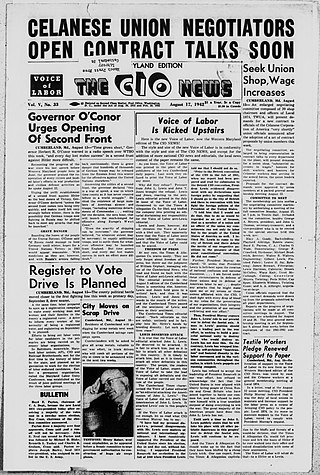
The Voice of Labor was a biweekly newspaper covering issues related to the labor movement and was published from December 1, 1938, to July 30, 1942, in Cumberland, Allegany County, Maryland, after which point it became the Western Maryland edition of The CIO News. It was originally founded in 1937 by labor activists James Blackwell and Clyde D. Lucas as The Voice during a time of great upheaval in the American labor movement. The paper was published by the Western Maryland Industrial Union Council of the Congress of Industrial Organizations (CIO). Blackwell was a veteran labor organizer and left-wing agitator who had previously led the People's Unemployment League in Baltimore and the city's United Auto Workers. He acted as the paper's inaugural managing editor until June 1941. Lucas was a native of western Maryland and leader of the textile workers at the massive Celanese plant in Cumberland.

The Frostburg Forum was a weekly newspaper published in Frostburg, Maryland, U.S. from 1897 to 1901. It was founded by John B. Williams and Henry Francis Cook, who had joined to form the Forum Publishing Co. Cook had already began publication of another newspaper, TheFrostburg News, earlier that same year, and would subsequently go on to publish TheFrostburg Gleaner in 1899. The paper was initially edited by George T. Goshorn, a veteran newspaperman who had previously published newspapers in West Virginia in addition to working for the Government Printing Office in Washington, D.C. By 1901, the Forum had been purchased by the Frostburg Home Building and Conveyance Company and was edited and published by its manager, N. Ralph Moore. The Forum ceased publication that same year, however, with Moore going on to edit the Linton Record.

The Frostburg Gleaner was a weekly newspaper that was published from 1899 to 1901 in Frostburg, Maryland, U.S. It was founded by Henry Francis Cook, who acted as editor and publisher for the paper's short existence. Cook had previously established The Frostburg Forum and The Frostburg News in 1897, and had also published the Friendsville Collaborator in nearby Friendsville, Maryland. After leaving the Forum shortly after its inception, Cook worked as a job printer until he started the Gleaner.
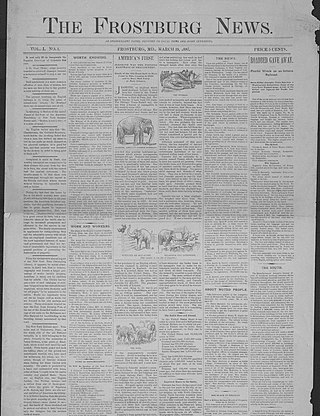
The Frostburg News was a weekly paper that was published from March 19, 1897, to April 1897 in Frostburg, Maryland, U.S. It was published by Henry Francis Cook, who would go on to publish The Frostburg Forum with John B. Williams later that same year; Cook also published The Frostburg Gleaner from 1899 to 1901. In the News' inaugural issue, Cook promised "never to imitate" the "mud-slinging" tendencies of other publications, telling readers that his paper was "the organ of no political party, creed or sect." Though Cook announced his acquisition of a new printing press in April 1897 that would allow expansion of the paper to an eight-column format, the newspaper would only publish a few more issues before ceasing altogether. This was presumably due to Cook joining forces with Williams to begin publishing the Forum.
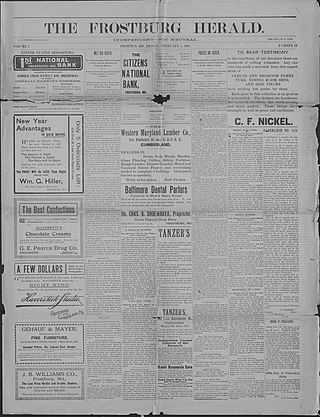
The Frostburg Herald was a weekly newspaper that was published from 1903 to around 1906 in Frostburg, Maryland, U.S. by John J. Robinson, a former coal miner. Robinson was also the editor of The Lonaconing Star from 1886 to 1905 in nearby Lonaconing, Maryland. The Herald's motto proclaimed that the publication was "Independent--Not Neutral," the same motto that Robinson used for the Star. The newspaper's editorial positions advocated for honest government and a fair shake for the working people of Maryland. Robinson made it known that the intent of his paper was "to boldly, jealously and relentlessly do all in its power to safeguard the interests of the people," exemplifying this in the same issue with an exposé of the Frostburg city council's secret meetings under the headline: "The People Were Not Consulted."
References
- ↑ "About Frostburg mining journal". Chronicling America: Historic American Newspapers. Library of Congress. Retrieved November 19, 2018.
- ↑ Feldstein, Albert L. (1987). Historic Newspapers of Allegany County. Vol. II. Cumberland, Maryland.
- ↑ Portrait and Biographical Record of the Sixth Congressional District, Maryland Containing Portraits and Biographies of Many Well Known Citizens of the Past and Present: Together with Portraits and Biographies of All the Presidents of the United States. Chapman Publishing Company. 1898. p. 521.
- 1 2 3 Scharf, John Thomas (2003). History of Western Maryland: Being a History of Frederick, Montgomery, Carroll, Washington, Allegany, and Garrett Counties from the Earliest Period to the Present Day, Including Biographical Sketches of Their Representative Men. Vol. 1 (Illustrated, reprint ed.). Genealogical Publishing Company. p. 1479. ISBN 0806345659.
- ↑ "About The Frostburg spirit". Chronicling America: Historic American Newspapers. Library of Congress. Retrieved November 19, 2018.
- ↑ Livengood, P.L. (January 28, 1915). "Valedictory". The Frostburg Spirit. Retrieved November 19, 2018.
- ↑ "About Frostburg mining journal". Chronicling America: Historic American Newspapers. Library of Congress. Retrieved November 19, 2018.
- ↑ Thomas, James Walter; Chew Williams, Thomas John (1923). History of Allegany County, Maryland Including Its Aboriginal History; the Colonial and Revolutionary Period; Its Settlement by the White Race and Subsequent Growth; a Description of Its Valuable Mining, Industrial and Agricultural Interests; Sketches of Its Cities, Towns and Districts; Master Spirits; Character Sketches of Founders; Military and Professional Men, Etc. Allegany County, Maryland: Higginson Book Company.
- ↑ Brugger, Robert J. (1996). Maryland, A Middle Temperament: 1634-1980 (Illustrated, reprint, revised ed.). JHU Press. p. 339. ISBN 0801854652.
- ↑ Harvey, Katherine A. (1969). The Best-Dressed Miners: Life and Labor in the Maryland Coal Region, 1835-1910 (Illustrated ed.). Cornell University Press.
The Best-Dressed Miners: Life and Labor in the Maryland Coal Region, 1835-1910.
- ↑ Johnson, David (2018). "Maryland Mines". Mining Artifacts and History Website. Retrieved 26 November 2018.